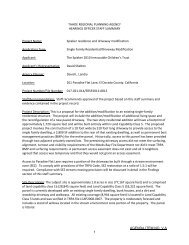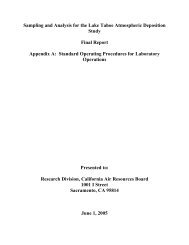FEIS - Tahoe Regional Planning Agency
FEIS - Tahoe Regional Planning Agency
FEIS - Tahoe Regional Planning Agency
Create successful ePaper yourself
Turn your PDF publications into a flip-book with our unique Google optimized e-Paper software.
RESPONSE TO COMMENTS ON THE DEIS<br />
B o u l d e r B a y C o m m u n i t y E n h a n c e m e n t P r o g r a m P r o j e c t E I S<br />
Mixed Use Model is based on more studies of mixed-use developments than the<br />
current ITE methodology, which is based on three survey locations in Florida.<br />
Master Response 3 provides additional clarification on internal/external Alternative<br />
mode trips.<br />
Comment 103-f: Comment Summary - The EIS should provide the base numbers of trips on which the<br />
“Alternate Mode Split” is based. It should not include internal trips.<br />
Please see response to comment 103-e.<br />
Comment 103-g: Comment Summary: The internal trip capture and alternate mode trip numbers in<br />
App. W are internally inconsistent in the "Trip Generation Spreadsheets" resulting in<br />
inconsistent numbers of external trips calculated for Alts. A and C. Consequently,<br />
the traffic impact analysis may be flawed.<br />
The internal capture and Alternative mode reductions for the Boulder Bay Project<br />
were calculated using two data sources: the Fehr & Peers mixed use development<br />
model (mixed use equations) and surveys conducted by LSC Transportation<br />
Consultants, Inc. (2007) at the existing <strong>Tahoe</strong> Biltmore. The data source collected at<br />
the project site (LSC) was applied to Alternative A (Existing Conditions). The Fehr<br />
& Peers mixed use development model data source was used for Alternative C<br />
because the mix of uses is different than the existing conditions. Master Response 3<br />
provides additional clarification on internal/external Alternative mode trips.<br />
Comment 103-h: Comment Summary - The EIS does not adequately document why the Biltmore would<br />
generate 5,581 trips vs. the actual 1,835.<br />
Please refer to Master Response 2, which compares the Proposed Project and<br />
Alternatives to an alternative existing baseline.<br />
Comment 103-i: Comment Summary - The use of higher estimated, instead of actual, trip generation<br />
rates at the Biltmore as the existing baseline condition erroneously reduces the<br />
impact conclusions of the EIS.<br />
Please refer to Master Response 2, which compares the Proposed Project and<br />
Alternatives to an alternative existing baseline.<br />
Comment 103-j: Comment Summary: From Spreadsheet: the analysis assumes all Alt. C trips would<br />
involve interacting uses, but only 1/3 for Alt. A and 1/2 for Alt. E. This seems<br />
erroneously because some Alt. C trips would be to visit external sites and services.<br />
Please see response to comment 100-e.<br />
Comment 103-k: Comment Summary - From Spreadsheet: There appears to be double counting: the<br />
base for computing Alternative mode trips for all Alternatives includes internal<br />
capture trips. It should include only external trips.<br />
Please see response to comment 103-e.<br />
Comment 103-l: Comment Summary - From Spreadsheet: Explain why the internal capture<br />
percentages for some types of interacting trips are different for the different<br />
Alternatives. Alternative E has different mode split percentages than the other<br />
Alternatives.<br />
Please see responses to comments 103-d and 103-g.<br />
Comment 103-m: Comment Summary - From Spreadsheet: Explain why the external trips are<br />
inconsistent with other pages in Appendix W.<br />
PAGE 8- 44 HAUGE BRUECK ASSOCIATES SEPTEMBER 8 , 2010






